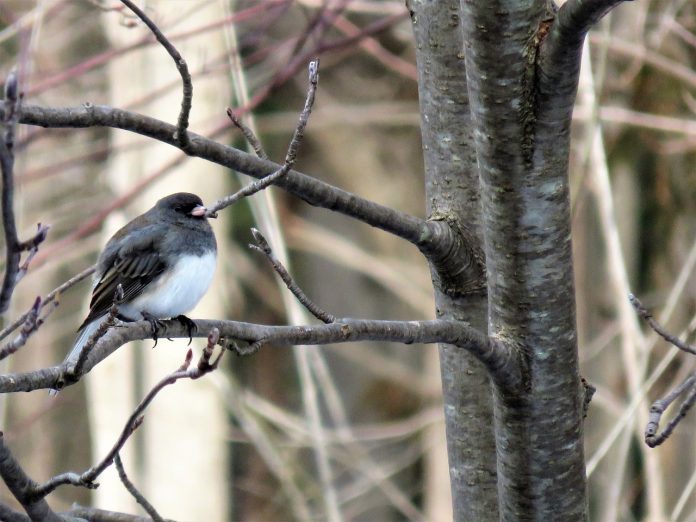Each spring birders anticipate the return of colorful neotropical migrants — warblers, vireos, orioles, and tanagers. Their vibrant colors and melodious songs remind us that another year of warm weather has returned.
In the fall, we eagerly await the reappearance of migratory birds that return to us from the north. Among the first to appear in October or November are Dark-eyed juncos.
They are often called “snowbirds” because they usually arrive in late October and stay until April.
This year, however, I did not see a junco until just a few days ago.
Juncos are easy to recognize. A charcoal-gray body contrasts with the white belly, white outer tail feathers, which flash in flight, and the bright pink bill.
The body of female juncos is a duller brownish-gray. According to results of the Cornell Laboratory of Ornithology’s Project FeederWatch, juncos are usually seen at more feeders across the continent than any other species.
Feeding preference
They prefer white millet, cracked corn, and black-oil sunflower seeds scattered on the ground or on low platform feeders. Winter flocks of juncos number 10 to 30 individuals.
When you watch juncos that come to your yard, notice two things. First, you’ll only see one flock at a time. Winter flocks defend feeding territories — they don’t tolerate competition from other flocks.
But when the weather turns cold and snowy, juncos become much less aggressive. I’ve counted as many as 47 juncos under my feeders during a snowstorm.
Pecking order
Second, within a flock there is a definite social hierarchy or pecking order.
Adult males occupy the top rung of the social ladder, followed by young males, adult females, and finally, young females.
Dominant individuals eat first. Lower ranking juncos wait their turn. Early in the morning and late in the day, when feeding is most intense, you’re most likely to observe aggression between dominant and subordinate individuals.
Dominance is probably determined by a combination of age, gender and experience. Juncos may be the most common and recognizable winter migrant, but several other species can be expected to visit backyard feeders stocked with the same seeds that attract juncos.
White-throated and white-crowned sparrows can be identified by their larger size and distinctive facial patterns. White-throats sport a prominent white throat, black and white crown stripes, and broad eyebrow stripes which are yellow in front of the eye and white or tan behind it.
And unlike most songbirds, which wait until spring to sing, white-throats may whistle, “Old Sam Peabody, Peabody, Peabody!” on any bright winter day.
White-crowns lack the bright white throat, and the head pattern consists of bold zebra-like black and white stripes. Tree sparrows usually arrive shortly before Christmas from their breeding grounds in northern Canada and Alaska and are easy to identify.
Traits of distinction
Look for a rusty crown, a fine rusty stripe behind the eye, two white wing bars, and, most importantly, a dark spot in the middle of an otherwise plain breast.
Despite their name, tree sparrows are not forest birds. They nest on the tundra among stunted trees and shrubs.
Visits by tree sparrows are particularly gratifying because they travel so far to reach our backyards. In winter, tree sparrows inhabit old fields, forest edges, and marshes where they roam in flocks of 30 to 40 individuals.
Within these flocks, smaller sub-groups of four to eight birds travel and feed together.
Fox sparrow
Another winter visitor from the north whose arrival often coincides with the holiday season is the fox sparrow. Among the largest sparrows, fox sparrows measure about 7 inches long and wear bright rusty feathers.
Heavy streaking across the chest converges to form a distinct central spot. When feeding, they make a lot of noise by kicking back the leaf litter with both feet like a towhee.
The calendar may tell us winter’s still a few weeks away, but the winter visitors remind us it’s time to keep the snow shovel handy.













